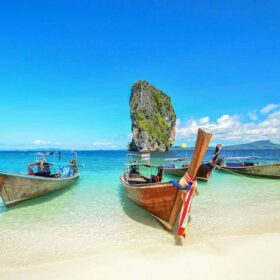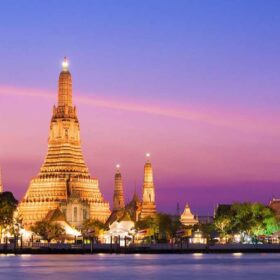ItJapan is an enigma. It is the ideal combination of time-honored customs with lightning-fast, cutting-edge technology; the two complement each other well. Many people who go to Japan for the first time are frequently taken aback when they realize that in addition to being one of the most sophisticated industrialized countries in the world, this tiny Asian country also has a rich and interesting history that extends back thousands upon thousands of years. Japan is located in East Asia.
In point of fact, Japan’s Shinto and Buddhist temples were already well-established and attracting pilgrims and patrons to their lavish architecture and décor long before many of Europe’s most stunning cathedrals were completed. At the same time, the nation was already honing the talents and crafts that would put it on the road to wealth, including the production of beautiful porcelains and ceramics as well as textiles like silk.
Despite the destruction caused by wars and natural disasters, a significant portion of this rich culture has been maintained (or restored), making a trip to Japan an unforgettable experience. Spending your time and money on a trip to Japan, which has an unending number of top attractions, interesting things to do, and areas of interest to discover, is without a doubt an excellent use of both of those resources.
Our list of the top tourist attractions in Japan might help you find the most interesting places to visit around the nation.
1. Mount Fuji
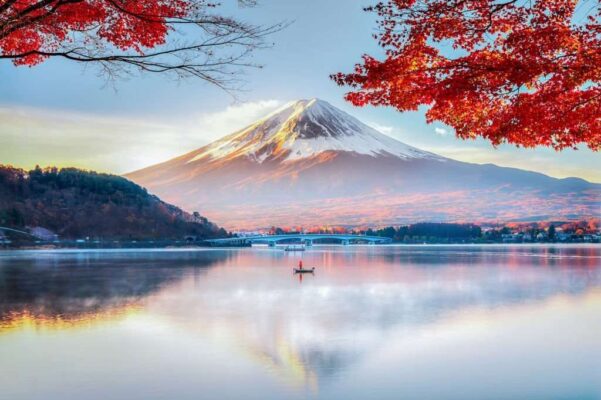
Mount Fuji, one of Japan’s sacred mountains, has a height of 3,776 meters. Visit Japan between December and January to see Mount Fuji at its best. Although the summit is frequently obscured by clouds, you should be able to view it in the morning. I may be seen from the following locations: Koyo-Dai, Mt. Fuji Panorama Ropeway, and Izunokuni Panorama Park.
Mount Fuji has been lauded in works of art and literature for countless centuries, and it is today regarded as such a significant emblem that in 2013, UNESCO acknowledged the mountain’s contribution to the culture of the world. Mount Fuji, which is located within the Fuji-Hakone-Izu National Park, is ascended by over one million people during the summer months as part of a religious pilgrimage. The highlight of this journey is seeing the sunrise from the mountain’s peak.
2. Tokyo Imperial Palace
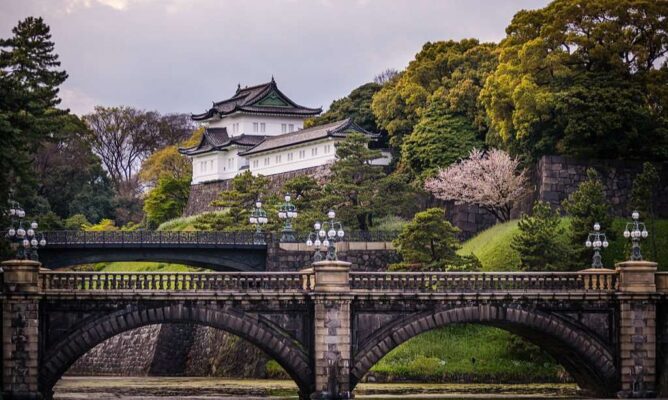
Tokyo Imperial Palace is the primary residence of the Emperor of Japan and is situated in the center of Tokyo. The palace, which was built in 1457, is surrounded by beautiful gardens and is a popular tourist site. If you want to avoid crowds, it is highly recommended that you arrive early.
Once you have arrived, a tour of the palace grounds with a guide is available to you. This includes the palace gardens in addition to the outer regions that are associated with the royal complex.
A museum that highlights the history and culture of the Japanese royal family may also be found inside the palace complex. Visitors are given the opportunity to acquire knowledge of the rituals and traditions practiced by the royal family. In addition, there is a wide selection of extraordinary artifacts and treasures that belonged to the royal family.
Accommodation: Where to Stay in Tokyo
3. Kiyomizu-dera, Kyoto

There are so many beautiful monuments and landmarks in Kyoto that the city is almost bursting at the seams. The city itself is a major draw. However, a trip to Kyoto would be incomplete without a stop at Kiyomizu-Dera, also known as the Pure Water Temple.
Kiyomizu-Dera, also known as the Otowa Waterfall Temple, was established there around 780 CE and is considered to be one of the most significant temples in all of Japan. It was initially constructed to be a part of the Hosso sect of Buddhism; but, in the middle of the 20th century, it eventually broke out and created its own sect.
Today, the UNESCO World Heritage Site is famous for its wooden stage, which looks out over the picturesque roofs of Kyoto, as well as for the magnificent trees, which always put on great color shows throughout the autumn season as well as during cherry blossom season.
Visitors will discover additional significant locations, such as the Jishu Shrine, on the grounds of the monument, in addition to the Otowa Waterfall itself, which may be seen gushing at the foot of the structure that houses the main hall.
Accommodation: Where to Stay in Kyoto
4. Fushimi Inari Shrine, Kyoto

When you visit Fushimi Inari-taisha Shrine, you will see red, but in a beautiful way. Fushimi Inari Shrine is located in southern Kyoto and is notable for the hundreds of scarlet-colored gates that arch over a network of paths. These arch-covered pathways compel stillness, so anticipate a very tranquil trek toward Mt. Inari’s Forest.
Inari is the Shinto deity of rice and one of Shintoism’s most significant gods. Fushimi Inari Shrine is unquestionably the most significant of the hundreds of temples devoted to him. Most visitors come to view the vermilion gates, but the shrine itself is worth exploring as well, and the structures are extremely stunning.
5. Shibuya Crossing, Tokyo

The Shibuya Crossing is commonly recognized as the busiest intersection in the world, and it can be found in the Shibuya neighborhood of Tokyo. It is made up of five intersections, each of which enables people to enter and go in every direction of the crossing. It is estimated that during the busiest part of the day, more than 3,000 people will cross it at the same time without colliding with each other, which makes for an incredible sight. The enormous commercial complex known as Shibuya Scramble Square is home to the well-known observation deck known as Shibuya Sky. From this deck, visitors can take in breathtaking views of the famous crossing as well as the surrounding skyscraper-filled area of Shibuya.
6. Itsukushima Shrine, Miyajima

Visiting the Hiroshima Prefecture is recommended for a number of reasons, including the Itsukushima Shrine. However, that is a pretty convincing argument.
It is one of the most recognizable sights in all of Japan, and its alluring torii gate is its most famous feature. The fantastic illusion created by this is that it is floating on the sea. The shrine was built in the sixth century and is now recognized by UNESCO as a World Heritage Site. It is believed to have magical qualities.
The ferry terminal on the mainland, which is located at Miyajimaguchi Station, provides convenient access to the shrine. While you’re there, you can also take some time to rest at the nearby park or go on a trek along some of the area’s gorgeous trails.
Accommodation: Where to Stay in Miyajima
7. Osaka Dotonbori

One of our favorite things to do in Japan at night is to meander around the Osaka Dotonbori, which is one of the city’s many famous shopping streets. Not only is it a terrific area to people watch, but it also has a genuine ‘wow’ quality to it.
This well-known commercial and entertainment area is easily identifiable due to its location around the Dotonbori Canal in the center of the city. It is filled with all of those bright and colorful large neon signs and billboards, which you have probably seen on TV before.
The well-known Glico Running Man and the Kani Doraku crab are two examples of this. Both of these things will hold your attention if you are anything like me.
The area is surrounded on all sides by stores, restaurants, and bars, in addition to the lights. In addition to that, it provides space for an incredible assortment of street food sellers. While you are there, you shouldn’t leave without trying the takoyaki (which are balls made of octopus) and the okonomiyaki (which are savory pancakes).
8. Shirakawago

Shirakawago is a destination that draws tourists from all over the world, regardless of their age or country since it is a UNESCO World Heritage Site. The picturesque town may be found in the prefecture of Gifu, which is known for its tranquil alpine areas. Gassho-zukuri, which are traditional Japanese architecture styles, are responsible for the breathtaking beauty that makes this location renowned all over the globe. It has a distinctive architectural style, such as a tall, thatched roof, which serves to shield the home from the heavy snowfall that occurs throughout the winter. When you go on an excursion around the lovely hamlet, you may also get a peek at the locals who, for ages upon centuries, have been responsible for preserving the breathtaking environment and the traditional way of life. During the winter, the tranquil town is transformed into a wintry landscape that is entirely blanketed in snow.
9. Nara Park
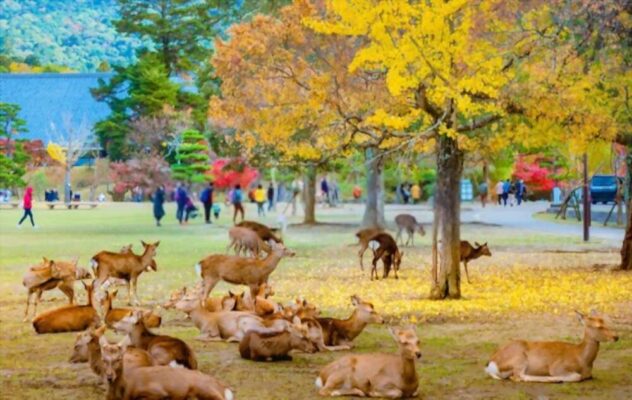
Another ancient city, Nara can be reached by rail from Kyoto in around half an hour’s time. Nara is noted for its long history. It is the location of a large number of historical sites, such as Todaiji. It is a Buddhist temple that was founded by Emperor Shomu in the early eighth century.
Traditional temples and historical landmarks are simply some of the attractions that Nara has to offer. The expansive Nara Park was first opened to the public in the year 1880. It has a total land area of around 502 hectares and is surrounded by a number of well-known ancient landmarks, including Todaiji, Kofukuji, and the Nara National Museum. Since there are more than a thousand deer living in the park, Nara Park is sometimes often referred to as “Deer Park.” You may purchase crackers to give to the deer, and some of the deer will even bow to you to acquire one of the crackers. Be wary, though, since even while these deer are normally gentle and sociable, they may become hostile when provoked. In the springtime, when the cherry blossoms are in full bloom, Nara Park becomes a popular destination.
10. Himeji Castle

Himeji Castle, which can be found in the city of the same name, is widely considered to be among the most significant tourist sites in all of Japan. It has been given the moniker “White Heron” because of the gleaming white exterior that it has, making it easy to see. It is one of the few castles in Japan that dates back to the feudal era and has been preserved.
Himeji Castle is Japan’s biggest and most popular castle, and backs in time to the 14th century. It is also the oldest castle in Japan. Strangely, the castle is the focus of a great deal of folklore in the area. The castle, which is a priceless cultural relic, provides extraordinary insights into the traditional culture of Japan.
11. Sapporo, Hokkaido

With about 2 million people, Sapporo is recognized as the most populous city on the island of Hokkaido. In addition to its function as a political and economic capital, it is home to a wide variety of tourist attractions and well-known gathering places, which bring in visitors from all over the globe. The Sapporo Clock Tower is a well-known landmark that dates back more than 130 years and has been recognized by the government as a National Important Cultural Property.
Goryokaku is a Japanese historical landmark with a star-shaped fort and a park known for its peacefulness. It is a popular place to observe cherry blossoms in the spring. Susukino is a buzzing drinking zone that provides a variety of exciting activities in addition to a number of Izakaya drinking establishments. The Sapporo Snow Festival in February draws crowds with its magnificent ice sculptures. Do not leave without trying the fresh seafood and regional specialties like Sapporo Miso ramen and premium crabs!
12. Matsumoto Castle

There are literally hundreds of stunning castles brimming with history all around Japan. But none of them can compare to the totality and enchantment of Matsumoto Castle. The city of Nagano is the location of Matsumoto, which was constructed between the years 1592 and 1614. Tip: One of the greatest times to visit the castle is in the spring when the grounds are dusted a gentle pink with the bloom of hundreds of cherry blossoms. This is one of the most beautiful periods of the year to see the castle.
The inside of the castle provides guests with one of the most authentic opportunities to go back in time. The timber interiors of Matsumoto Castle have been preserved, offering visitors an authentic taste of the castle’s long history. Matsumoto Castle is one of the five castles that have been given the title of “National Treasures of Japan.” It is the oldest castle tower in the nation that is still standing and has six stories.
FAQs
What is the best time to visit Japan?
The best time to visit Japan is during the spring (March to May) or fall (September to November) seasons.
- During the spring, Japan is filled with beautiful cherry blossoms, which usually bloom from late March to early April. This is a popular time for tourists, so it can be crowded, and accommodations may be more expensive. However, the weather is mild and pleasant, making it a great time for outdoor activities and sightseeing.
- In the fall, the autumn leaves or “Koyo” can be seen throughout Japan, creating stunning landscapes with vibrant colors. The weather is also comfortable, making it a great time for hiking and other outdoor activities.
What is the smallest town in Japan?
The smallest town in Japan is Kamikatsu, located in the Tokushima Prefecture on the island of Shikoku.
What are the famous places in Japan?
Famous places in Japan include: Tokyo, Kyoto, Mount Fuji, Hiroshima, Nara, Osaka, Okinawa, etc.
Are there any temples in Japan?
Yes, Japan is known for its many temples. In fact, temples are an integral part of Japanese culture and history. Temples are religious sites that are dedicated to Buddhism, which is one of the main religions in Japan. There are thousands of temples in Japan, each with their own unique history and architectural style. Some of the most famous temples in Japan include: Kinkaku-ji (Golden Pavilion), Kiyomizu-dera, and Horyu-ji, etc.
Where can I go free in Tokyo?
There are several free attractions in Tokyo that visitors can explore without spending any money. Here are some suggestions: Oyogi Park, Shinjuku Gyoen National Garden, Ueno Park, Meiji Jingu Shrine and Senso-ji Temple, etc.
Why is Japan called a tourist attraction?
Japan’s unique combination of traditional and contemporary culture is a major tourist draw.
Japan’s cuisine is another draw for tourists. Japanese food emphasizes presentation and fresh, high-quality ingredients. From sushi and sashimi to ramen and udon, there is something for everyone in Japan’s culinary scene.







